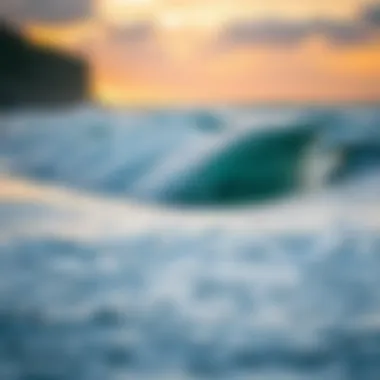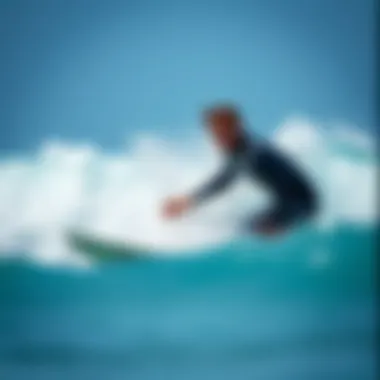Understanding Tidal Times for Better Surfing


Intro
Surfing isn’t merely about hopping on a board and catching a wave. There’s a whole world of factors that come into play, one of the most critical being the tides. Understanding tidal patterns isn't just for marine biologists; it's essential for anyone serious about catching that perfect swell. Tides influence everything from the size of the waves to the safety of the surfing environment. Many surfers, especially those who are just starting out, might underestimate the power of tides. Without grasping how tides work, they could easily find themselves in precarious situations, or worse, missing out on ideal conditions altogether.
The rhythm of the sea is dictated by the moon, the sun, and the earth’s rotation, all intertwined in an intricate dance. This natural phenomena produces tides that can significantly enhance or diminish surf conditions. For example, many surfers gravitate toward the mid-tide phases, where the waves are often both manageable and exhilarating. As the tide rises or lowers, it can change the wave structure, which can either serve up exhilarating rides or challenging smash-ups against the rocks.
Moreover, tides don’t operate in a vacuum. They interact with local conditions like wind speed, swell direction, and underwater topography to create a unique surfing experience at each beach. In this article, we’ll take a detailed dive into the fenomenon of tides and their relevance in the surfing world.
So, whether you're a novice rider or an old sea dog, knowing the ins and outs of tidal times can shape your surfing outings. You may discover a new respect for the ocean and a keener understanding of how you can enhance your enjoyment of this timeless sport.
Let's navigate through the essential gear and skills that can make those tidal adventures more fruitful and safe!
Gear and Equipment
Surfing requires a variety of gear, and having the right equipment can profoundly affect your performance. Understanding tidal times and how they interplay with your chosen gear can make the difference between an average day at the beach and a memorable session full of adrenaline-pumping rides.
Latest Surfboard Technologies
The surfboard you choose can greatly impact your ability to utilize tidal conditions effectively. With advances in technology, surfboards now come equipped with features designed to give surfers an edge. Here are a few notable innovations to keep in mind:
- Lightweight Materials: Boards made from epoxy or carbon fiber are lighter but equally sturdy. This allows for better maneuverability, especially vital when chasing waves at changing tidal times.
- Flexible Design: Some boards, like shortboards and fish boards, are created with flex patterns tailored for high-performance surfing. Agile boards can react quickly to shifting wave dynamics caused by tidal changes.
- Fin Systems: Consider boards with adjustable fin setups. Tides affect wave shape, and having the ability to modify your fin placement can offer the optimal drive or looseness your surfing demands.
In sum, your choice of board can make or break your surfing experience. Knowing how to match your equipment with the surf conditions brought on by the tides is key.
Essential Accessories for Every Surfer
In addition to your board, several accessories can enhance your surfing journey, especially regarding safety and comfort:
- Leash: Always invest in a high-quality leash. It's your lifeline to your board and keeps you safe—especially in rough tidal conditions.
- Wax: Depending on the water temperature, use the right wax for your board to maintain grip. Remember, wax loses its effectiveness if the tidal waters are too warm!
- Wetsuits: The interaction of the ocean and air temperatures can fluctuate widely with different tides. A good wetsuit keeps you warm and buoyant as conditions shift.
- Sunscreen: Protect your skin; it's easy to forget this in the heat of the moment. Being out in the sun can be detrimental, especially during low tide when you might spend more time sitting on the beach.
Choosing quality gear tailored for the conditions is crucial—tides can create unexpected challenges or present incredible opportunities. Prepare accordingly to ensure that you're ready to ride and play it safe, all while embracing the wonders that the ocean has to offer.
The Importance of Tidal Timing in Surfboarding
Tidal timing plays a crucial role for surfers, dictating not just the best waves to catch but also the safety of the surfing experience. Understanding the rhythm of the ocean allows a surfer to select the optimal time to hit the water. Whether you’re a seasoned pro or barely dipping your toes in, knowing when to surf can make all the difference.
When surfers talk about tides, they aren't just rattling off a list of numbers; they're engaging with a complex natural phenomenon that significantly impacts wave shape, size, and behavior. The relationship between tides and surf conditions cannot be overstated. Variations in tide levels affect the way waves break, the speed at which they come toward the shore, and even the type of waves that will form.
Benefits of Understanding Tidal Timing
- Enhanced Wave Quality: Certain tidal states can produce optimal wave conditions. For instance, a low tide might reveal a sandbar that produces a cleaner wave, while high tide might lead to choppy conditions.
- Safety Considerations: Recognizing how tides change the basic dynamics of the surf, like current strength and wave height, helps surfers stay safe and avoid dangerous situations, such as rip currents.
- Optimal Surf Strategy: Timing one's surfing session with the tide cycle enhances overall performance. Surfers can adapt their techniques to match the ever-changing conditions that different tides present.
Things to Consider About Tidal Timing
- Location Matters: Coastal regions can have remarkably different tidal influences. A beach known for its high waves at low tide might not perform the same way at another location.
- Local Knowledge: Tides are affected not just by the moon, but also by local geography, weather patterns, and seasonal changes. Getting to know your local surf spot can make all the difference in your experience.


"The ocean’s rhythm knows no equal; learning its timing takes effort but pays off richly in wave and safety."
In short, understanding tidal timing in surfboarding is about more than just catching the next wave. It's about navigating the delicate balance between nature's forces and the enthusiastic pursuit of the surf experience. By honing in on this knowledge, surfers can significantly elevate their skills and enjoyment in the water.
Tidal Terminology: Key Concepts Explained
When it comes to understanding surf conditions, knowing the tidal terminology is essential. This section breaks down key concepts that surfboard enthusiasts must grasp in order to fully appreciate how tides impact their experience in the water. Knowledge of these terms helps surfers anticipate wave behavior and ensures safer outings. Without this understanding, even the most skilled surfers might miss the nuances of the ocean's rhythm.
High and Low Tides
High and low tides are the fundamentals of tidal patterns. These are determined primarily by the gravitational pull of the moon and, to a lesser extent, the sun. During a high tide, the water reaches its peak; conversely, during low tide, the water is at its nadir.
- High Tides: Often coincide with larger swell patterns, making for more exhilarating surf conditions. Novice surfers might find these challenging but exciting.
- Low Tides: Create shallower waters, which can expose rocky bottoms or sandbars, potentially resulting in less favorable conditions for riding waves.
For surfers, timing is everything. A surf session planned around high tide can yield more powerful waves, while low tide can slow things down considerably. It’s vital for surfers to track local schedules, usually found in tide charts, to make informed decisions.
Spring and Neap Tides
Spring and neap tides involve the variety in tidal ranges observed throughout the lunar cycle. While they might sound like terms from a history book, they play a significant role in surf conditions.
- Spring Tides: Occur when the sun, moon, and Earth align, leading to a substantial difference between high and low tides. These tides bring larger waves, often resulting in better surf conditions, attracting more surfers and setting the stage for excellent riding experiences.
- Neap Tides: Arise when the sun and moon are at right angles, causing minimal tidal differences. Wave action can be less dramatic during these times, which might frustrate seasoned surfers eager for the thrills that spring tides promise.
Understanding the interplay of these tidal variations allows surfers to create accurate strategies for their surf sessions. From the thrilling swells of spring tides to the more subdued conditions of neap tides, adjusting your surfing approach based on these cycles can be the difference between riding a wave and sitting on the shore.
Surfers who recognize the importance of tidal cycles are often the ones who catch the best waves.
Determining Tidal Times Near Your Location
Understanding tidal times specific to your location is crucial for surfers eager to make the best out of their wave-riding sessions. It can be the difference between catching the perfect wave or slogging through choppy waters. The aanalogies comparing tides to a canvas emphasize that every surf spot paints a different picture based on the tide. Knowing when to paddle out means tapping into the natural rhythms of the ocean.
It’s essential to remember that local factors determine how tides behave. Since currents, local bathymetry, and nearby land can alter wave conditions, each surf spot is unique. It can be quite beneficial to have a reliable grasp on tidal schedules to optimize your surf experience. This involves understanding how high tides might create ideal conditions for certain boards, while low tides can expose rocks or reefs, possibly creating dangerous situations.
Tide Predictions: Overview and Methods
Tide predictions generally rely on well-documented phenomena. One of the most reliable methods is to check established feeding systems, which use historical data. Many coastal areas offer resources based on years of detective work by sea-loving enthusiasts and scientists alike. Various methods help determine tidal behaviors, such as:
- Harmonic analysis: Computed using astronomical and geometric principles to forecast tide levels based on the positions of the moon and sun.
- Computer models: These model real-time interactions, referencing the coast’s geography to provide predicted tide heights.
Getting accustomed to how different locations handle tides helps surfers make educated decisions.
Utilizing Online Resources
The internet is a treasure trove for surfers seeking timely tidal information. Websites such as Tide Charts, NOAA's Tides & Currents, and Surfline offers up-to-date data through user-friendly interfaces. Many mobile applications have also sprung up that can offer tide information right at your fingertips. These online resources provide:
- Real-time updates on tidal movements
- Tide calendars specific to your favorite surf spots
- Community forecasts from other locals or enthusiasts sharing their experiences


Keep an eye on social media platforms. Groups on Reddit or Facebook centered on surfing often engage in dialogue sharing their own tide observations and surf reports.
Local Tide Charts: How to Access Them
When it comes to local conditions, traditional tide charts remain a steadfast option. These charts outline the rise and fall of tides based on specific time frames. So, how does one access them? Here’s a step-by-step approach:
- Visit Government Websites: Most local governmental bodies maintain a reliable source of tide charts.
- Check Marina or Harbor Offices: These places often distribute detailed tide charts and are filled with individuals who are knowledgeable about local tidal behavior.
- Look for Community Bulletin Boards: Sometimes surf shops or local beaches will post physical copies of tide charts.
Pro tip: It can be wise to rotate these charts or synchronize them with moon phases and weather patterns for the best surfing schedule. After doing this homework, you should find that the ocean can be your ally, rather than a mystery.
"Surfing activities hinge at times upon tides. Understanding them means not just riding, but thriving on experiences that enrich our love for the ocean."
When you have a solid grasp of tidal times, everything flows more naturally, from safety considerations to adding joy to each surf session. It's time to put this knowledge to the test and ride each tide like a seasoned pro.
Using Tidal Information for Surf Strategies
When it comes to surfing, knowledge is power, and understanding tidal information can make or break a day on the waves. An effective surf strategy hinges on being in sync with the tides; it is not just about catching a wave but catching the right wave. Unsurprisingly, tide schedules dictate everything from wave height to the currents that can either aid or thwart a surfer’s ride. By comprehending how to utilize tidal data, surfers can find those ideal conditions that put them ahead of the pack.
The benefits of harnessing this information are manifold:
- Targeted Surf Times: Knowing when high and low tides occur can help in planning surf sessions. Many surfers prefer high tide for optimal conditions.
- Better Wave Quality: Some breaks work better during certain tidal stages, shaping the quality of the surf dramatically.
- Safety Measures: Understanding tides also plays a monumental role in ensuring safety, minimizing risks like rip currents that typically occur during aggressive tidal flow.
At the core of any successful surfing strategy is an understanding of how tide conditions interact with local surf breaks. With this knowledge under your belt, you can pick the best times for surfing.
Optimal Conditions for Surfing
What makes the waves truly rideable? Several factors come into play, influenced largely by tidal times. Most seasoned surfers will tell you that timing your surf to coincide with the tides often yields the best results.
- High Tides vs. Low Tides: High tide often brings waves that are full and steep—ideal for those looking for a thrilling ride. In contrast, low tides can expose reefs and sandbars, which can either enhance or mangle your experience depending on the location.
- Tide Height: The measurement of tide height can indicate whether you are about to witness a magic hour of surfing. It’s wise to familiarize yourself with your local breaks to learn how they react to different heights.
"The tide changes, but the ocean stays the same. Understand the tides, and the ocean begins to speak."
- Wind Conditions: Wind can also play a significant role when you plan your surf. Combine favorable wind conditions with optimal tidal times, and you have a recipe for great surfing.
Understanding these elements allows surfers to craft their day, transforming it from a chance encounter with the waves into a well-orchestrated symphony of elements.
Tides and Wave Quality
Wave quality is a topic that gets surfers excited, and rightly so. Not all waves are created equal; various tidal stages significantly influence swell, shape, and overall ride quality. When the tide rises and lowers, it stirs up the ocean bed, generating different wave shapes and heights.
- Breaking Patterns: A wave’s breaking pattern during high tide may differ drastically from low tide. For instance, some spots build powerful waves on rising tides, while others might favor a retreating tide for quality surf.
- Current Dynamics: Tides also affect ocean currents. A strong current can wreak havoc on your ability to paddle out, or conversely, can help you return to the shore more easily.
If you're serious about improving your surf technique, paying attention to how tides affect wave quality is a non-negotiable. Stay observant, note variations in wave behavior at different tidal phases, and adjust your strategy accordingly. This diligence pays off more than you’d think, especially as you aim to capture the elusive perfect wave.
Safety Considerations Related to Tides


Tidal activity is a major component of coastal environments, yet many surfers overlook its significance when planning a session. Understanding the tidal patterns not only enhances one’s surfing potential but can also ensure safety in and around the water. Tidal forces can have unpredictable effects on currents, wave heights, and other conditions, which can pose various risks to surfers. Precaution is paramount. Knowing local tidal patterns can prevent accidents and save lives.
Rip Currents and Tidal Flow
Rip currents, often described as powerful, narrow channels of fast-moving water, can be particularly dangerous during specific tidal times. During high tide, the influx of water can stir up currents, creating stronger rip flows that can catch even experienced surfers off guard.
Here are some key points to consider regarding rip currents and tidal flow:
- Stay Aware of Conditions: Always check local surf forecasts before heading into the water, as conditions can change quickly.
- Look for Color Changes: Often, rip currents can be identified by water that appears darker or more turbulent than surrounding areas. This difference indicates a strong current flowing away from shore.
- Escape Techniques: If caught in a rip current, it’s critical to swim parallel to the shore until free from the current’s grip, instead of attempting to swim directly back to land which could lead to exhaustion.
"The best advice is sometimes learning to read the ocean rather than fighting it. Understanding the tidal currents can make all the difference in having a fun day or a dangerous one."
By learning to recognize rip currents during various tidal phases, surfers can better protect themselves and their friends.
Understanding Local Hazards
Each beach possesses unique characteristics influenced by local geography, weather patterns, and tidal activities. It’s essential for surfers to familiarize themselves with these hazards before plunging into the waves. Potential hazards might include rocky outcrops, tidal pools, or sudden changes in seabed topography.
Key hazards to keep an eye on include:
- Rocky Points: Some locations have prominent reef structures or rocky shorelines that can be dangerous, especially during low tide when more of the rocks are exposed.
- Quick Changes: As tides shift, so do the surf breaks. A spot that might be safe at high tide could be considerably more hazardous at low tide.
- Wildlife Encounters: Some areas might have marine life that poses risks, like jellyfish being washed ashore during certain tidal conditions.
Understanding these factors plays a crucial role in planning safe surfing trips. Engaging with local surf communities and online forums can also offer insight into prevalent hazards. Platforms like Reddit can provide anecdotal evidence from fellow surfers and experienced locals.
Cultural Significance of Tidal Knowledge
Understanding tidal times goes beyond mere mechanics for surfers; it’s soaked in cultural values, traditions, and a profound respect for nature. Tidal knowledge is not just about catching the next wave; it encompasses a digital tapestry of beliefs, rituals, and lifestyles that connect people to the sea. Recognizing this significance can enhance one’s surfing experience, deepening the bond between the surfer and the environment.
The intimate relationship between surfing and the tidal rhythms reflects not just practical concerns but also a historical legacy. Surfers often learn to read the tides from family or mentors, fostering a community bond that values tradition and shared experiences. In many coastal cultures, knowledge about tides is passed from generation to generation, weaving a rich narrative into the cultural fabric.
Future of Tidal Forecasting Technologies
As surfing evolves, so does the technology behind tidal forecasting. Understanding the future of tidal forecasting technologies is vital for surfers, anglers, and coastal communities who rely heavily on the ocean's rhythm. Accurate tidal predictions can dramatically enhance surf conditions, enabling enthusiasts to ride the best waves with confidence. With advancements in technology, tidal forecasting is becoming more precise, reliable, and accessible, paving the way for a new era of aquatic sports.
Innovations in Tide Prediction
Recent years have seen a surge in innovation when it comes to predicting tides. Here are some of the notables:
- Satellite Technology: One avenue making great strides is the integration of satellite data in tidal prediction models. Satellites collect vast amounts of information, helping predict tidal patterns with unprecedented accuracy. This allows for real-time updates and adjustments based on shifting weather conditions.
- Machine Learning Algorithms: Incorporating machine learning into tidal forecasting aids in creating models that can learn patterns over time. Instead of relying solely on historical data, these algorithms analyze current maritime conditions as well, making forecasts more dynamic and responsive to changes.
- Mobile Applications: A host of mobile apps have been developed to keep modern surfers informed. Apps like Magicseaweed and Surfline provide not just tide schedules, but also wave reports and real-time updates. Users can see predictions at their favorite spots, enhancing planning for surf sessions.
"With technology always advancing, the ability to adapt these tools for our needs will change the way we interact with the ocean."
By adapting to these innovations, sailors can enhance their experience, maximizing their time in the water while staying safe.
Integrating Technology with Surfing
As tidal forecasting technologies become more sophisticated, so do the methods surfers use to harness this information. Integration of tech with surfing isn’t just about predictions; it’s about a holistic approach to ocean interaction.
- Smart Surfboards: Enhanced sensor technologies embedded in surfboards track wave performance and provide feedback to surfers. This data can include paddle stroke efficiency, wave height, and speed, which can then be correlated with tidal times to identify optimal surf conditions.
- Wearable Technology: Devices such as smartwatches are becoming commonplace among surfers. They're infused with tidal and wave condition data. Such gadgets can alert surfers to tidal changes and provide live updates, ensuring enthusiasts are always in the right place at the right time.
- Community Platforms: Social media and online forums have transformed how surfers share tidal information. Whether it’s through Reddit or specialized surfing networks, sharing real-time information about tide conditions has introduced a collaborative way to plan surf trips. Surf communities can discuss local conditions that might not be covered in standard forecasts.
As tidal forecasting technologies continue to advance, they foster not only better surf experiences but also a deeper connection with the ocean. Enthusiasts can make the most of their time in the water, armed with knowledge about the tides and how they influence surf conditions. The future looks bright for those who thrive on riding the waves.







